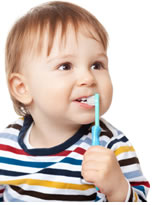
 Promoting Oral Health in Child Care
Promoting Oral Health in Child CareHow you can help
It is widely accepted that encouraging children to look after their teeth from a young age makes them more likely to have good oral hygiene as an adult.
With significant numbers of children spending time in care every week, this means child care providers have an increasingly important role in promoting good oral hygiene.
According to the Centre for Community Child Health, dental health in children has improved in the last decade, however it is still of concern and an estimated 50 per cent of children aged six years have caries. A recent study of dental decay in young children also showed that approximately 84 per cent of children aged four years start school with clinically detectable untreated decay.
In preschool children the most common causes of decay are:
- delayed tooth brushing
- irregular/incorrect tooth brushing
- prolonged use of bottles especially through the night
- use of dummies coated in sweet substances
- frequent snacking
- high sugar consumption
- lack of parental awareness/concern
Parents have the primary responsibility for teaching their children how to look after their teeth and gums however child care providers have an important role in supporting and enforcing what children learn at home.
Good habits and high standards of dental health among children in care can be achieved by:
- Developing oral health policies and strategies in consultation with dentists, parents and staff.
- Recording contact details for children's dental practitioner on enrolment.
- Advising parents if staff notice any sign of tooth decay, such as swelling, injury to teeth, bleeding in gums, pain when chewing etc.
- Maintaining age appropriate dental health education programs and books to encourage interest and awareness among children.
- Avoid putting babies and young children to bed with a bottle.
- Avoid the use of pacifiers dipped in sweet substances such as honey.
- Offer fluoridated water as a preference to any other drink.
- Limit the number of sugary snacks offered to children throughout the day.
- Offer children food which encourages them to chew.
- Encourage children who are old enough to rinse their mouth out with water after each meal and snack.
- Think about implementing a tooth brushing program.
- Baby's gums and teeth should be wiped with a clean, damp face cloth or cotton gauze to remove plaque and milk.
- Be aware that some children may not brush their teeth at home and the introduction of a tooth brushing program provides an opportunity for children and families to learn about good oral health and to develop and practice skills to support what they learn.
- Children need to be around two years old to benefit from a tooth brushing program, they should be able to hold a brush and be able to learn to spit and rinse and not swallow the paste.
- Small, soft children's toothbrushes should be used along with low-fluoride toothpaste.
- Toothbrushes should be individually labelled and stored separately to avoid cross contamination.
- Toothbrushes should be washed and air dried at the end of the day.
- Children need a pea sized amount of toothpaste which should be pressed into the bristles.
- Children's teeth should be brushed or the brushing supervised until they can master the technique for themselves.
- It is unnecessary to use mouthwashes for children unless prescribed by a doctor or dentist.
- Young children should only brush their teeth twice a day.
First Aid for a knocked out or chipped baby tooth
If a child has a dental injury where the tooth is chipped or the whole tooth is knocked out:
- Manage as an emergency, inform the parents/family.
- DO NOT reinsert the tooth back into the socket. Baby teeth are not usually placed backing the gum.
- Gently rinse the tooth or tooth fragments in milk to remove blood and place in a clean container or wrap in cling wrap to give to the parent or dentist.
- Seek dental advice as soon as possible and ensure that the tooth/tooth fragments are taken to the dentist with the child.
- Complete an injury report form.
- Gently rinse the tooth and tooth fragments in milk for a few seconds to remove excess dirt and blood.
- Handle the tooth by its crown (the white enamel top part of the tooth), not its root and be careful not to rub off the endothelial (tissue) fragments on the root of the tooth, as these are needed for the tooth to take if replaced by the dentist.
- Replace the tooth back in the socket (be certain that the tooth is placed into the socket the correct way round – compare to the teeth next to it, the front surface usually convex outwards).
- Seek dental advice as soon as possible and ensure the family takes the child to the dentist with the tooth/tooth fragments within 30 minutes, as the root endothelial layer begins to deteriorate after 30 minutes.
- If the tooth has been in contact with dirt or soil, advise the family that tetanus prophylaxis may be required and advise them to consult with both their dentist and doctor.
© 2012 - All rights reserved
Care For Kids Internet Services Pty Ltd
ABN 55 104 145 735
PO Box 543 Balmain NSW 2041
privacy policy contact us